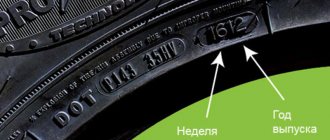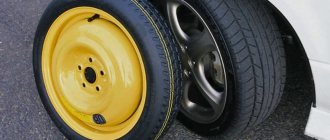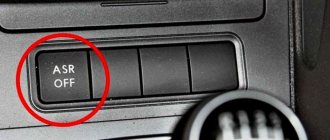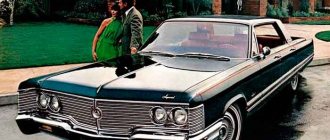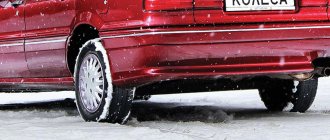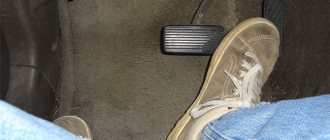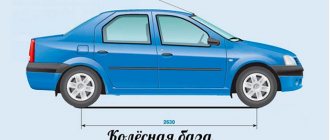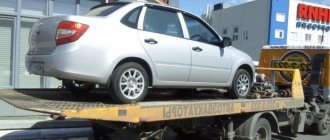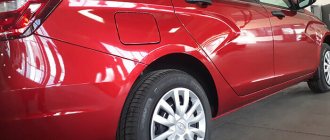What is dokatka
A spare wheel that is the same size as the wheel of the main, working set, but has differences in tire width, is called an emergency wheel or “re-roller”. A standard attachment is included in most cars, has a distinctive color and is mounted in a special compartment in the trunk.
The purpose of such a spare tire is to independently drive to the nearest tire shop, garage or store in case of a puncture or damage to a car tire.
Dokatka or standard spare tire: differences, advantages and disadvantages of each option
To decide what is better to carry in the car in case of tire damage, a re-roller or a standard wheel configuration, a detailed analysis will help, what is the difference between tire products? The differences lie not only in the visual aspect, but also in the technical parameters of the products, which determine their operational and advantageous aspects.
Spare devices differ according to the following criteria:
- The obvious, visual difference between the products lies in the discrepancy in dimensions. To be able to get to the nearest tire repair point, it is enough that the spare wheel does not differ from the standard wheels in diametrical size: the thickness of the tire and the disk of the temporary device is smaller.
- The second parameter that distinguishes a spare wheel from a re-roller is predetermined by the weight of the structures. The latter, due to its reduced size and simplified configuration, is lighter.
- Wheel products are also retailed according to pricing policy: a standardized class spare tire is designed for long-term use, therefore it is made from high-quality materials, in compliance with procedural standards that meet modern technological requirements, which leads to the high cost of the product. The operation of the dokatka is provided only in emergency situations; the product is designed for low mileage, therefore it is made from cheaper materials, which determines its final, relatively low cost.
- The product also differs in terms of reliability: tires intended for regular use are characterized by fundamental advantages that affect the operational safety of the product.
- The quality of production of re-rolling tires is significantly lower, this is especially reflected in the wear resistance of the tread, which is designed for short kilometers and wears out quickly.
Compared to a standard configuration wheel, the re-roller is significantly inferior in terms of quality indicators and service life. Among the disadvantages of using additional products, drivers highlight the following nuances:
- It makes driving more difficult, since the alternative device has a small contact surface with the road surface, which is reflected in the dynamics of the car, its behavior when cornering, and the braking distance increases.
- High probability of tire damage due to poor workmanship on uneven, bumpy sections of the road.
- Negative impact on the differential and suspension elements of the vehicle due to the huge difference in angular trajectories at speed.
What is the difference between a rolling wheel and a regular wheel?
The emergency wheel has a lightweight design, since it is used for emergency replacement of a damaged wheel of the main set in unfavorable conditions: on the highway, during rain or at low air temperatures.
Weight
The weight of the re-roller is significantly reduced compared to the weight of the main set wheel. The reason for this is:
- the stamped disk has a lightweight design and smaller width;
- nominal tire width is 1/3 smaller;
- The tire thickness is smaller due to a small layer of fabric cord and the height of the tread.
This design of the dock is designed to reduce the space occupied in the trunk of a car and increase ease of installation.
Standard sizes
The outer diameter of the emergency wheel must match the size of the wheels of the work kit.
In emergency cases, it is possible to install wheels with a difference of one unit, for example, instead of R14, install R13 or R15, but you should be prepared for a significant decrease in the maneuverability of the car and increased wear of suspension parts.
Quality
The emergency wheel is manufactured and tested in accordance with the methods established by GOST R 41.64 - 99 “Uniform regulations concerning the official approval of vehicles equipped with spare wheels/tires for temporary use.” Consequently, the quality of the ride meets safety requirements, and driving such a car is quite comfortable, but subject to strict adherence to the speed limit and time of use.
Strength
The method and materials for manufacturing a spare wheel provide for a maximum re-rolling mileage of 2500 – 3000 km, depending on the manufacturer. Until this value is reached, the emergency wheel meets all strength requirements and ensures safe movement.
Price
The price of the emergency wheel is reduced due to:
- disc production method - stamping and welding;
- disc material – carbon steel;
- simplified tire cord manufacturing technology;
- absence of additional inserts in the tire structure.
The cost of re-rolling a middle-class car varies from 600 to 2,500 rubles.
What pressure should be in the dock?
The operating or maximum permissible pressure in the tires of the main set and the emergency wheel is indicated in the vehicle operating instructions. In addition, such information can be printed on the pillar between the driver's side doors or on the side surface of the tire itself. The average value is 4.0 – 5.5 atm depending on the car model.
It is important to remember that the maximum possible pressure is 25% higher than the rated operating pressure.
On which axle can the dokatka be installed?
The general recommendations of emergency wheel manufacturers are that it is necessary to install the tire on a non-drive axle. However, there are some nuances:
- Four-wheel drive vehicle . Installing a temporary wheel on the rear axle only. If the front wheel is damaged, it is necessary to replace it with any wheel from the rear axle, and put a “dokatka” in its place.
- Front wheel drive car:
- Installing an emergency wheel on the front axle makes it difficult to start moving, increases the braking distance and reduces the vehicle's stability when cornering.
- The wheel on the rear axle does not affect the maneuverability of the car and has virtually no effect on braking.
- Rear wheel drive car:
- Rolling on the front axle does not affect the distribution of power flows, but can cause an increase in braking distance. It is recommended to enter a turn at a speed of no more than 20 km/h, especially in adverse weather conditions.
- A spare tire installed behind the rear axle has little effect on the braking process, but reduces the car’s maneuverability when cornering and requires attention when starting to move - you need to move away slowly, without jerking.
Thus, the optimal solution is to install a tire on the rear axle of the car. If this is not possible, it is necessary to strengthen control over the steering while driving.
At what speed can you go on a dock?
Since the dokatka is essentially an emergency wheel, the speed of the car should not exceed the 60 km/h established by the rules, despite the fact that manufacturers allow the use of such a wheel at speeds of up to 80 km/h.
It is important to remember that the maneuverability of a vehicle with a rollover is significantly reduced, so the speed limit should be chosen based on the driver’s experience and road conditions.
What to do if a tire breaks down
Signs of a breakdown are easy to notice on the go:
- handling deteriorates noticeably, yaw along the road is noticeable;
- the car doesn’t hold its direction well and moves to the side when braking and accelerating;
- You can feel the car rocking.
In this case, you need to immediately stop on the side of the road and check the wheels. If one of them is empty, it's time to take the hazard sign out of the trunk and install it. Then you need to loosen the nuts on the broken wheel, jack up the car, and put on the spare tire. Before driving, the spare tire must be pumped up to the required pressure.
After this, you can continue driving, but to the nearest service station or auto shop to fix a flat tire or buy a new one. Moreover, driving on the spare tire is allowed at a speed of no more than 90 km/h, or better yet, even less, since handling will be worse, and the spare tire is not always a full-fledged wheel.
How long can you ride on a dock?
If the diameter of the tire coincides with the diameter of the main wheels, then the distance that can be driven on it is 200 km in dry and warm weather, in winter - no more than 50 - 100 km.
If the size of the rolling wheel is larger or smaller than the other wheels (for example, the main wheels are 16 in diameter, and the rolling wheel is either 15 or 17), then the distance should be halved.
Rules for riding a dock
The main nuances when driving a car with a tire are as follows:
- due to the smaller wheel width, the contact area of the tire with the road surface is reduced, which leads to an increase in braking distance;
- the coefficient of adhesion of the tire to the road is reduced due to the shallow depth of the tread pattern, which threatens to impair the maneuverability of the vehicle;
- In power flows transmitted from the engine to wheels of the same axle, which have different masses, the relationship between angular velocities is disrupted, which leads to losses in efficiency and possible slipping on the road.
Since a tire puncture and installation of a spare tire is an emergency, taking into account all the nuances, when driving such a car you must adhere to the following rules:
- If possible, do not place a spare tire on the drive axle;
- do not use a wheel with low tire pressure;
- install an emergency wheel equal in outer diameter;
- disable electronic wheel locking systems when installing a wheel that has different outer diameters;
- do not exceed speed;
- move away smoothly, avoid sudden pressure on the gas pedal;
- reduce speed on turns to 20 - 40 km/h;
- The rotation of the steering wheel should be smooth and avoid jerking;
- Braking should begin in advance, avoiding sudden pressure on the pedal.
It is important to remember that the braking distance of a car with a spare wheel is always increased, regardless of weather conditions.
“Dokatka”: definition of the term and the history of the need for a spare tire
The need to equip the car with an additional wheel, and more than one, arose almost simultaneously with the first car rolling off the assembly line. The reason was the poor quality of the road surface of those times, which in most cases was a primer or paved road surface with an abundance of piercing and cutting elements on the road. Accordingly, precedents involving mechanical damage to rubber on a car in ancient times were almost standard phenomena, which provoked the need to equip vehicles with wheels to carry out prompt repairs on the road.
Previously, cars were equipped with not one, but even several spare tires, since the likelihood of damage to the tires was too great. Over time, with the increase in the number of cars on the roads, the quality of the road surface has improved significantly, however, the need for a spare wheel still exists today. Nowadays, there is no need to carry several spare wheels, however, one spare tire is necessary for quickly replacing damaged tires on the road, with the prospect of carrying out independent repairs, saving money and time on calling specialists or a tow truck to deliver the vehicle to a service station.
Today there are two options for equipping vehicles with a spare wheel:
- Purchasing a standard wheel identical to the tires installed on the car.
- Purchasing the so-called “dokatka”, which is a more affordable version of a backup tire, with smaller parameters and simplified technical properties.
Technically, re-rolling is a solution to the problem of a damaged wheel and allows it to be replaced. The term “dokatka” is an abbreviation for the word “dokat”, which predetermines the possibility of only temporary operation of the device in order to get to the nearest vehicle service station. It is absolutely impossible to use such a wheel on an ongoing basis, due to its simplified operational properties and smaller parameters in comparison with standard “shoes”. Spare tires are already actively used by many car owners; in some modern cars they are included with the vehicle from the factory, and are also available for sale and presented in a decent assortment, which allows any car owner to choose and purchase a budget spare tire option. Mostly, such wheels can be visually recognized by the bright, contrasting color of the device disk.
Let's consider further how to choose an alternative spare tire, in the form of a spare tire, for a vehicle, what features and characteristics of the product should be taken into account by a potential buyer when making a choice.
Pros of dokatki
Using a tire as a spare tire has the following advantages:
- small size;
- low cost;
- simplicity and ease of installation;
- no need to periodically replace the spare wheel with the main wheels in order to ensure uniform wear.
As long as you comply with the speed limit and braking rules, driving a car with a rollover is absolutely safe and quite comfortable.
Is it possible to ride on a tire?
The traffic rules in this matter are clear: the tire tire is used only in an emergency, and you can only ride it to the place of repair - to a tire repair shop or to a garage.
It is not designed for speed and has distance restrictions. The fine for constant use of the dokatka is 500 rubles.
An emergency tire will allow you to quickly get out of a difficult situation and get to a repair shop, but only if the tire was punctured not during a long trip. You cannot use the tire all the time; before the trip, you need to properly inflate it and monitor the pressure level. And yet, a full-size spare tire remains the best option for replacement - it allows you to not lose either speed or control.
Disadvantages of dokatka
The disadvantages of using a dokatka are as follows:
- Wheel pressure, tire condition and tread height must be checked regularly;
- due to the reduced area of adhesion between the wheel and the road, the braking distance increases and the maneuverability of the vehicle at high speed deteriorates;
- There is a risk of damage to the spare tire when driving on rough roads at high speeds (over 60 km/h).
Failure of the ABS, ESP or DSTC electronic systems only occurs when installing a wheel of a smaller diameter, since the difference in size is perceived as slipping or slipping.
How to choose a document
To choose the right tire for your car, you should focus on the following indicators:
- size – must completely match the size of the wheels of the main set;
- rubber quality - a dry and cracked tire will quickly fail;
- tread depth - the shallower it is, the worse the grip on the road.
The best tire is a wheel made for each specific car brand.
The emergency wheel is the best choice as a spare wheel. Having a low cost and good quality indicators, the dokatka takes up little space in the trunk and does not require special care. An important condition is that you must move to the nearest service station in compliance with safe traffic rules.
Nuances of product selection
The question of how to choose the right tire for your vehicle is more than relevant for car owners, since the possibility of its installation, should such a need arise, and the level of safety of the car when driving on an alternative wheel depend on this.
When selecting a product, you must primarily focus on the diametrical size of the device, which should correspond as much as possible in this parameter to the calibration of a standard format tire. Otherwise, the operation of the product will be impossible due to the large difference between the wheels.
Regardless of the criterion, whether a wheel is purchased for regular use or temporary use, it is important to make the selection taking into account the authority of the product manufacturer, as well as to give preference to products manufactured for a specific brand of car. Such precaution will guarantee the possibility of operating the product, taking into account the weight of the machine, and compliance with the fastening elements for a specific vehicle.

